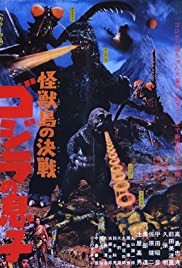Son of Godzilla [Kaijûtô no kessen: Gojira no musuko] * (1967, Tadao Takashima, Akira Kubo, Beverly Maeda) – Classic Movie Review 9960
Son of Godzilla [Kaijûtô no kessen: Gojira no musuko] (1967) is the second of five films in the series directed by Jun Fukuda (1923–2000). Another island themed Japanese kaiju film adventure, it is the eighth film in the Godzilla franchise. The writers are Shin’ichi Sekizawa and Kazue Shiba.
Godzilla rescues and befriends a cute baby dinosaur, Minilla (or Minya in the American dubbed versions), who becomes his adopted son. Along comes a spider (the giant spider Kumonga) and a praying mantis to sit down beside them, and dad is beside himself.
Minilla (or Minya) is born on Sollgel Island, where his egg is cracked open by the mutant giant mantises, Kamacuras (Gimantis in the English-dubbed version). Two of them are killed by Godzilla, who rescues Minilla and trains him against attacks from the remaining Kamacuras and the Kumonga.
Notice that, despite the title Son of Godzilla, what does not happen in this film is that Godzilla’s wife gives birth to a cute baby dinosaur. There is no dino sex in the movie, or a Mrs Godzilla, despite the producers’ idea of making a film to appeal to the date crowd, who were probably going on to have sex themselves after the movie. So, with no dino sex or Mrs Godzilla, they decided to give the normally aggressively male Godzilla a maternal appearance with a parent-like stature next to Minilla by making a new fat Godzilla suit. This is head-bangingly weird.
Son of Godzilla [Kaijûtô no kessen: Gojira no musuko] is an endearing but monstrously silly Japanese fantasy movie, which goes for laughs and mainly only gets unintentional ones. After disappointing box office for the previous two Godzilla movies, Toho Studios decided to change tack and steer Godzilla mainly towards audiences of children, a course that failed at box office.
Toho Studios wanted to create a baby Godzilla to appeal to the date crowd, with the idea that girls would like a cute baby monster. Date movies were particularly popular among young couples at this time.
However Fukuda said he saw Minilla’s creation as a new approach for the series, not an attempt to appeal to audiences of children. “We wanted to take a new approach,’ he said. ‘So we gave Godzilla a child. We thought it would be a little strange if we gave Godzilla a daughter so we gave him a son.’ He wanted to portray the monsters almost as people: ‘We focused on the relationship between Godzilla and his son throughout.’
Nevertheless, there is low murder and mayhem, and disappointingly little plot, action and destruction. The budget was low too, giving the director of Special Effects Sadamasa Arikawa (under the supervision by Eiji Tsuburaya) a headache,
Godzilla’s new monster suit is one of the poorest designed in the series, with fat and ugly legs, eyes and head. It the biggest in terms of size and girth in the series. And, after Godzilla reaches the island, a different suit is used for the water scenes, changing Godzilla’s appearance absurdly.
Marchan the Dwarf plays Minilla, hired to play the character partly for his ability to perform athletic rolls and flips inside his thick rubber suit.
Puppets are used to portray the Island’s gigantic inhabitants, with 20 puppeteers at a time working on the various marionettes. The massive Kumonga puppet needed two or three people to operate each leg.
Haruo Nakajima is again Godzilla/ Gojira, though he only plays Godzilla in two scenes because the new monster suit was much too big for him, so he reused the smaller suit he had worn for the Ebirah, Terror of the Deep. Otherwise, Godzilla is played by the much larger Seji Onaka, but he broke his fingers midway through filming and was replaced by Hiroshi Sekita.
Nakajima played Godzilla/ Gojira in 12 films, more than any other actor, suffering many injuries, including burns, electric shocks and near-suffocation. He said: ‘It was important to show the pathos of the creature, which could only smash everything in its way.’ Sadly, recent Godzilla films use computer graphic animations, though a Japanese remake released in 2016 used an actor, Mansai Nomura, whose movements were duplicated by CGI motion capture technology.
Haruo Nakajima died of complications from pneumonia on August 7, 2017 in Japan, aged 88. Ironically he was only 5′ 6″ tall.
The main cast are Tadao Takashima, Akira Kubo, Beverly Maeda [Bibari Maeda], Akihiko Hirata, Kenji Sahara, Yoshio Tsuchiya, Ken’ichirô Maruyama, Yasuhiko Saijô and Seishirô Kuno.
Ebirah, Terror of the Deep (1966) [Gojira, Ebirâ, Mosura: Nankai no daiketto] [Ebirah, Horror of the Deep] [Godzilla vs the Sea Monster] is the first of five films in the series directed by Jun Fukuda, followed by Son of Godzilla (1967), War of the Monsters (1972), Godzilla vs Megalon (1973) and Godzilla vs Cosmic Monster (1974).
Son of Godzilla [Kaijûtô no kessen: Gojira no musuko] is directed by Jun Fukuda, runs 86 minutes, is made by Toho Company, is released by American International Pictures (US) and Orb Films (1969) (UK), is written by Shinichi Sekizawa and Kazue Shiba, is shot in Eastmancolor by Kazuo Yamada, is produced by Tomoyuki Tanaka, is scored by Maruro Yamada and is designed by Takeo Kita.
The filming location is Guam.
Minilla reappears in Destroy All Monsters (1968), All Monsters Attack aka Godzilla’s Revenge (1969) and Godzilla: Final Wars (2004).
© Derek Winnert 2020 Classic Movie Review 9960
Check out more reviews on http://derekwinnert.com


